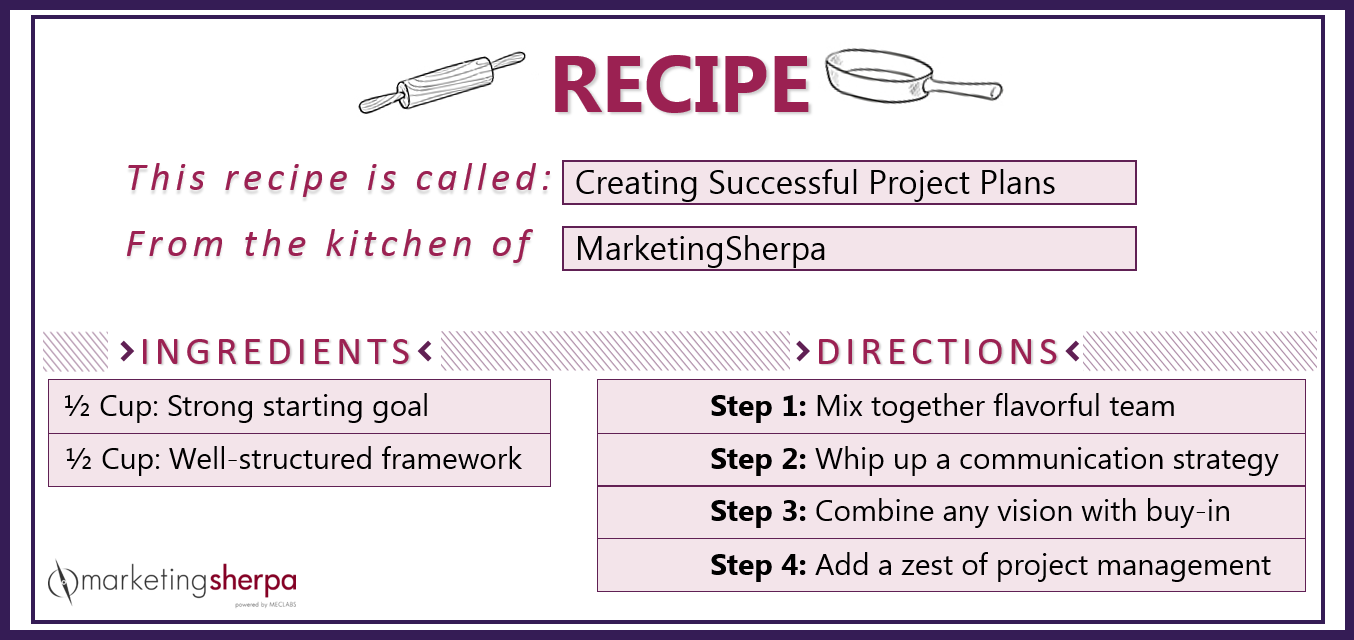Recipe for Creating Successful Project Plans
I love to bake and never turn down a chance to have a sweet treat. Everyone always tells me that they don’t have the time, energy or patience to bake. As a highly process-oriented person, my entire life is built around planning and executing projects of all sizes. I know how effective organization can optimize time and effort, so I’d like to share my “recipe” on how you can create successful projects from your company “kitchen.”
What you will need: A strong starting goal and well-structured framework to begin building your process.
To assemble:
Step 1: Mix together a flavorful team
When it comes to success, you can’t do it alone. It takes a great group of people to achieve an overall goal. In my opinion, the ultimate team consists of happy, motivated individuals with passion and commitment for the project who follow a great leader.
The leader of the project’s key role is to add value to the team by helping to support them in their goals. But the most important part of the mix is the project manager. This person takes ownership and wears many hats, as well as moves mountains for the team. Think of the PM of the “special sauce,” if you will — the secret to bringing everything together in the best possible way.
You don’t always have to have all the ingredients that you want to make your desired cake, but you can influence how the cake is made.
Step 2: Whip up a communication strategy
After you’ve created the team mixture, you’ll need to incorporate a basic and clear communication strategy. Ensuring that every person involved maintains an open dialogue is necessary.
Establishing the framework for the strategy could consist of a monthly touchpoint (if the project is long in duration), or quick weekly status meetings and well-organized written emails. Coordinate both group and individual meetings if necessary.
Also, utilize distribution lists within your email provider for the team so that no one is left out any of the conversations. Developing and maintaining the strategy has such a positive outcome on the results of the projects.
Step 3: Combine vision with buy-in
A vision without buy-in can fall short, like a soufflé.
The leader of the project needs to be able to clearly communicate their vision. Try involving the team early in the planning process to secure the buy-in in the future. Buy-in needs to be agreed on by the team, not just the high stakeholders. You want the employees to feel like they are appreciated and valued. Just as a strategy is built to communicate with the team, you’ll need the same communication for the vision. Don’t forget to follow-up in the event rework is required.
Step 4: Add a zest of project management
Zest is the outer peel of citrus fruit, used to add flavor to your meal. When developing projects, you want to start with that outer peel and dig as deep as you can, and the best place to start is with a “discovery workshop.”
Here you’ll want to create a brief with your clients or stakeholders by asking all of the right questions to establish goals, determine the user experience, ideal strategy and project timeline. It also helps the client to thoroughly think through the process to avoid any bombshells in the end of the project. We’ve all been there, when you try to add in a “surprise” ingredient at the end of the dish and it doesn’t always have the desired result.
Then, you’ll want to host an internal project meeting with your team to ensure that everyone is on the same page, and that the project has the greatest chance of success.
The project manager should set the tone, style and vision for the entire project in this meeting by walking through a detailed kick-off agenda that includes time for Q-and-A in the end. Many of the items on the agenda are going to have ongoing discussions ahead of the client kickoff meeting.
As with any recipe, when you put it together (hopefully) you’ll have an amazing tasting dessert or marketing project plan. So, if you desire to be the best “baker” in your “kitchen” who can be counted on to make things happen, get ready to get your hands dirty and make some messes.
Serves: Your entire marketing team!
You might also like
How Companies Fail, and Why the Customer Always Wins in the End
Charles Duhigg on How You Can Use Habit to Influence Customer Behavior
From 0 to 233,000 Members: 7 steps to running an effective LinkedIn group
Categories: Marketing Marketing, project planning, project plans










